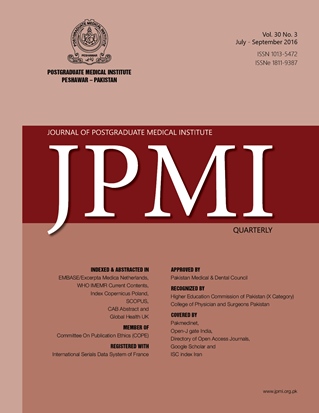ASSESSMENT OF EPIDEMIOIOGICAL PROFILE OF VARIOUS ENT DISEASES IN SCHOOL GOING CHILDREN AND THE TRENDS OF SEEKING HEALTHCARE IN SHANGLA VALLEY
Main Article Content
Abstract
Objective: To evaluate the epidemiological profile of various ENT diseases
in school going children and trends of seeking healthcare i.e consulting ENT
specialist, general physicians and quacks in Shangla valley.
Methodology: This was a cross-sectional descriptive study. The study was
carried out in district Shangla, Khyber Pakhtunkhwa in May-July 2014. The
author visited eight schools in the district Shangla and carried out thorough
ENT examination of the students and took relevant history to find out the
prevalence of various oto-rhino-laryngological diseases in the school going
children. Students of the eight schools of Shangla valley with age between 5
to 16 years were included in the study. The students, who were found to be
suffering from ENT diseases, were also asked whether they have consulted
any physician, oto-rhino-laryngologist (ENT specialist) or any quack for the
subject purpose. Simple descriptive statistics were used to describe frequencies
and percentages.
Results: Total 2882 students were examined in the eight schools. Ear wax was
found in 769 (26.7%) cases. 11 (1.4%) of ear wax cases had consulted an ENT
specialist, 37(4.8%) had consulted general physician and 71 (9.2%) went to
see quacks. Second common ENT condition encountered was rhinosinusitis,
which was seen in 11.6% of school children. 4 (1.2%) of rhinosinusitis patients
had consulted ENT specialist, 35(10.4%) had seen general physicians
and 69(20.5%) had gone to quacks for treatment.
Conclusion: Oto-rhino-laryngological (ENT) diseases are considerable burden
and important health problem in school going children of Shangla Valley.
Currently trend of consulting quacks is highest, followed by physicians and
ENT specialists.
in school going children and trends of seeking healthcare i.e consulting ENT
specialist, general physicians and quacks in Shangla valley.
Methodology: This was a cross-sectional descriptive study. The study was
carried out in district Shangla, Khyber Pakhtunkhwa in May-July 2014. The
author visited eight schools in the district Shangla and carried out thorough
ENT examination of the students and took relevant history to find out the
prevalence of various oto-rhino-laryngological diseases in the school going
children. Students of the eight schools of Shangla valley with age between 5
to 16 years were included in the study. The students, who were found to be
suffering from ENT diseases, were also asked whether they have consulted
any physician, oto-rhino-laryngologist (ENT specialist) or any quack for the
subject purpose. Simple descriptive statistics were used to describe frequencies
and percentages.
Results: Total 2882 students were examined in the eight schools. Ear wax was
found in 769 (26.7%) cases. 11 (1.4%) of ear wax cases had consulted an ENT
specialist, 37(4.8%) had consulted general physician and 71 (9.2%) went to
see quacks. Second common ENT condition encountered was rhinosinusitis,
which was seen in 11.6% of school children. 4 (1.2%) of rhinosinusitis patients
had consulted ENT specialist, 35(10.4%) had seen general physicians
and 69(20.5%) had gone to quacks for treatment.
Conclusion: Oto-rhino-laryngological (ENT) diseases are considerable burden
and important health problem in school going children of Shangla Valley.
Currently trend of consulting quacks is highest, followed by physicians and
ENT specialists.
Article Details
How to Cite
1.
Khan MA, Akram S, Usman HB, Khushdil A. ASSESSMENT OF EPIDEMIOIOGICAL PROFILE OF VARIOUS ENT DISEASES IN SCHOOL GOING CHILDREN AND THE TRENDS OF SEEKING HEALTHCARE IN SHANGLA VALLEY. J Postgrad Med Inst [Internet]. 2016 Jul. 18 [cited 2025 Dec. 13];30(3). Available from: https://jpmi.org.pk/index.php/jpmi/article/view/1925
Issue
Section
Original Article
Work published in JPMI is licensed under a
Creative Commons Attribution-NonCommercial 2.0 Generic License.
Authors are permitted and encouraged to post their work online (e.g., in institutional repositories or on their website) prior to and during the submission process, as it can lead to productive exchanges, as well as earlier and greater citation of published work.


